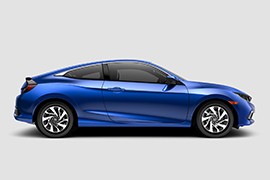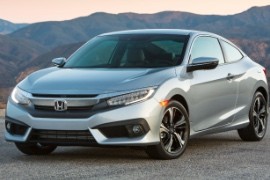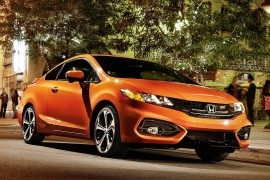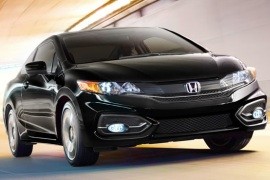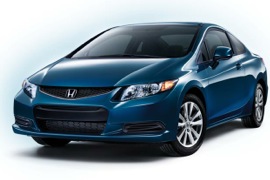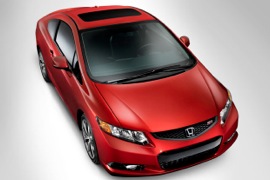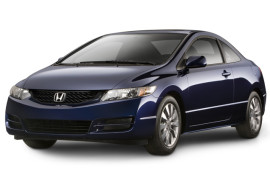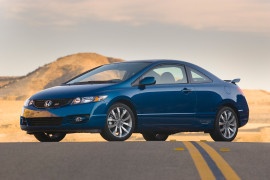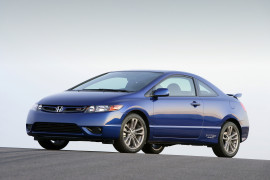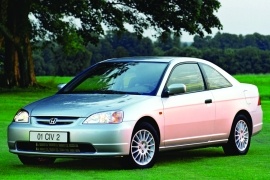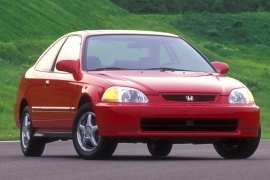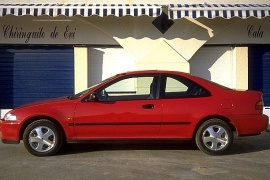HONDA Civic Coupe Models/Series Timeline, Specifications & Photos
First production year: 1994
Engines: Gasoline
Body style: Coupé (two-door)
The 2019 Honda Civic Coupe was introduced along with the facelift for the entire tenth generation of the compact Civic. It featured new improvements in the equipment and accessories.
The tenth generation of the Civic Coupe came back with better suspension, better safety equipment, better styling and a big trunk. But it also came with some design flaws that had to be corrected. In 2018, Honda showed that it listened to its customers and changed the Civic and the Civic Coupe.
For the 2019 model year, the Civic Coupe was offered in four different trims: LX, Sport, EX and Touring. It was also offered as SI as a separate offer on the market, with its own package that was added to the special engine. The restyled lower bumper gave the Civic a wider look and it was complemented by new, blacked-out headlights. On Touring trim, the LED headlights were upgraded with a new design to give the lights a wider and longer beam. At the rear, Civic Sedan's lower bumper has received a chrome strip. Civic Coupe has received a special new color named Tonic Yellow Pearl.
Inside, the 2019 model featured an upgraded sound system that featured a volume knob. The non-facelift version was highly criticized by customers and media for replacing the classic knob with a touch-slider that was harder to operate while driving.
For the Sport trim level, the Coupe received a naturally aspirated 2.0-liter engine that was mated as standard with a 6-speed manual or an option for a CVT. The other trim levels featured the 1.5-liter turbocharged unit.
Honda offered the tenth generation of the Civic also in a coupe shape on the North American market, making the European fans angry because it was not available there.
The tenth generation of the Civic was a significant step forward in the car's evolution. Finally, the Japanese carmaker understood that it had to ditch the beam suspension in the back and make the economical vehicle more fun to drive again. Moreover, it was lighter than its predecessor.
Sharing the front fascia with its four-door sibling was not such a bad idea. Yet, the chromed fat trim between the headlights led to a love-it-or-hate-it relationship with Honda's customers. But from the profile, the car had a truly sporty look. The raked windshield and the sloped roof to the back left the image of a fastback. And yet, its trunk opened independently, and the rear windscreen stayed in place. Depending on the trim level, the car came with a slight wing on the back.
Inside, the dashboard featured three LCDs, with the middle one for the tachometer and the speedometer. It was flanked by the temperature and fuel-level digital gauges. On the center stack, the carmaker installed the infotainment system and added the turn-volume knob, which was unavailable on the tenth-generation Civic from the beginning. The bench was good just for two passengers in the back, although with limited headroom.
Under the hood, the Civic Coupe was offered with a choice of two gasoline engines: a 2.0-liter naturally-aspirated aspirated and a turbocharged 1.5-liter unit. The former was available with a six-speed manual, while the latter was available exclusively with a sluggish CVT at the time of the launch.
The 2015 SI might be one of the last, true-blood, VTEC sports-coupe built by Honda. It had a look, the engine and the transmission it needed.
The refreshed Civic Si Coupe dust-off some of the old design elements and brought new ones, but it turned out to be a mixed feeling about it. It was a car bought for what it could do on the streets and not in the parking spot.
The Civic Si showed a similar look as its predecessor, with a wide and narrow grille to cool the engine. There were other air-intakes in the apron: one for the engine compartment and two for the brakes. The designers installed the fog lights inside the side scoops. The raked windshield was even more angled than the one on the five-door version, and the sloped roof design resembled the lines from the 8th-gen Accord Coupe. The wing on the trunk filled and completed the profile. Unlike other car-makers who opted for two exhausts to make a stronger impression, Honda chose only one side pipe.
The interior was the one that needed some updates, and Honda did it. It installed bucket seats with two-tone upholstery. As for other Civic models, the instrument cluster was separated into two steps: a tachometer behind the steering wheel and the rest of the information on an upper display. But Honda forgot to install a turning knob for the volume and thought that a touch-slider should do the job. Indeed, it can do the job, but it was annoying, and everyone complained about that.
Under the hood, the Si featured the same bullet-proof K24 engine. Unlike other turbo versions of the Civic, it offered more low-end torque. The 6-speed gearbox was fitted with a standard, mechanical, limited-slip differential.
Honda updated the Coupe version of the ninth Civic generation in 2015 and improved it with new design elements.
The refreshed Civic Coupe tried to make the popular sporty coupe in trend. But its new elements brought mixed feelings about the car since the brand's enthusiasts expected something more than just some posh on the headlights and standard bigger wheels.
The Civic Si showed a similar look as its predecessor, with a broad and narrow grille to cool the engine. There were other air-intakes in the apron: one for the engine compartment and two for the brakes. The designers installed the fog lights inside the side scoops. The raked windshield was even more angled than the one on the five-door version, and the sloped roof design resembled the lines from the 8th-gen Accord Coupe. The wing on the trunk was optional and completed the profile. Unlike other car-makers who opted for two exhausts to make a stronger impression, Honda chose only one side pipe.
Its interior was the one that needed some updates, and Honda did it. It installed bucket seats with two-tone upholstery. As for other Civic models, the instrument cluster was separated into two steps: a tachometer behind the steering wheel and the rest of the information on an upper display. But Honda forgot to install a turning knob for the volume and thought that a touch-slider should do the job. Indeed, it can do the job, but it was annoying, and everyone complained about that.
The Coupe version featured the same 1.8-liter R18 gasoline engine paired to a standard 6-speed manual under the hood. A CVT gearbox was offered as an option.
Honda introduced the ninth Civic generation in 2011, and, like its predecessors, it was available in a coupe shape, following the same successful recipe of lightness and trouble-free maintenance.
The carmaker delayed the car's introduction due to the weak car market. It feared that a new model wouldn't get enough sales and, by the time the sales will rise up again, it will already be outdated. So, it waited until December 2010 to announce the model and introduced it in both coupe and sedan shapes in Detroit at the 2011 North American International Motor Show.
Honda's designers made the car with an aggressive styling and a sharp nose. Its smiling front grille was flanked by the slim headlights, swept-back over the front fenders. The bumper featured a wide and tall grille, compared to the front fascia's size, and two side-scoops for the fog lights, if installed. Its raked windshield was followed by a short, curved roof extended in the back by a sloped-down windscreen and a short trunk lid.
Inside, the carmaker installed a two-step dashboard design. The tachometer was placed in front of the steering wheel and, in an upper cluster, the speedometer and other indicators for the fuel level and coolant temperature. Honda put an infotainment system on the center stack with a touch-screen navigation unit depending on the options. Its bolstered bucket seats were primarily designed for comfort. Those who wished more side-support had to wait until 2012, when Honda introduced the SI version.
Under the hood, the carmaker offered only one engine option, a 1.8-liter naturally aspirated VTEC engine. It paired it with a five-speed manual or to a five-speed automatic.
Honda introduced the ninth generation of the Civic Coupe in 2012, and the fans expected its most potent version, the Si.
While the Europeans received a turbocharged TypeR, Honda left the U.S. customers with a naturally aspirated four-pot unit, which was slightly more powerful than the eighth-generation Si. At least, it was available as a coupe with independent suspension in all corners, unlike its European sibling, which came with a torsion beam at the back.
The exterior look was a step ahead of its predecessor, but it wasn't a masterpiece. For the Si range, Honda installed an aggressive-looking bumper with a broad grille that sported a honeycomb pattern. A pair of fog lights adorned the side-scoops. From its sides, its unique 17" light-alloy wheels and the VTEC decals placed on the rear quarter panels confirmed the boy-racer look of the vehicle, while the small wing mounted on the trunk's lid completed the sporty image.
Inside, Honda worked hard on improving the car's interior with new technologies. Behind the steering wheel, the carmaker installed the tachometer and moved the speedometer and other gauges on an upper instrument cluster at the bottom of the windshield. The infotainment unit was on top of the center stack, which was tilted toward the driver. Like all Civics Si before it, the ninth generation model featured a set of sport bucket seats at the front with Si red stitching on the seatbacks.
Under the hood, Honda dropped the former squared 2.0-liter engine and replaced it with a 2.4-liter unit carried over from the Accord. It won only four horses when compared with the Civic's eighth-generation, but it gained more torque. A six-speed, close-ratio, manual gearbox was the only option.
Honda introduced a facelifted version for the Civic's eight-generation in 2008, and, along with the rest of the range, it refreshed the coupe version as well.
By 2008, the Civic Coupe was more than just another sport-compact coupe vehicle on the market. It gained a status icon among teenagers. Its low displacement and high-power output allowed them to buy it and didn't break the bank for the insurance.
The refreshed version featured clear-lens headlights and a revised front bumper, without fog-lights. Its side-pods featured a horizontal slat, but they were only fake air-intakes. Only the one in the middle was functional to cool the AC-compressor and help to cool the engine. From the side, depending on the trim level, Honda installed a small lip on the trunk lid. The SI version featured an oval exhaust, while the less-powered, 1.8-liter version was available with a round pipe. The carmaker offered the Civic Coupe with 15" light-alloy wheels fitted as standard, while a 16" set was on the options list.
Inside, the bolstered seats were well designed for more comfort but with enough side bolstering. The dual instrument cluster featured the speedometer onto an upper part on the bottom of the windshield, while the tachometer was placed behind the steering wheel.
Honda offered the 2008 Civic with a 6-speed manual for the 1.8-liter engine and a CVT gearbox choice.
Honda refreshed the eighth generation of the Civic in 2008, and the Coupe Si version received an update as well, but without an improvement under the hood.
The Civic Coupe Si already reached a cult car among the teenagers, and its sporty qualities convinced them to learn how to drive a manual since Honda didn't make it with an automatic version. Also, it was an efficient vehicle, suitable as a daily driver, good enough to carry four people inside.
Like its non-Si brother, the sportiest compact coupe from Honda featured new, clear-lens headlights and a revised front bumper design. Its upper black-mesh grille sported the red Si badge and black trim around. The carmaker cut a wide grille with three horizontal black slats on the apron, flanked by a pair of scoops for the fog lights. They also served as cooling ducts for the front disc brakes. A set of 17" light-alloy wheels enhanced the car's sporty look, while at the back, a small wing adorned the trunk lid.
Inside, the Si version featured sport bucket seats with integrated headrests. Like any of its predecessors, it sported a red middle section with black wings and bolsters. The low-mounted dashboard included two clusters: one for the speedometer installed on the upper side and the second one in front of the steering wheel for the tachometer and other information regarding the engine. Honda also included a set of metallic pedals in the Si package.
Under the hood, the Japanese carmaker kept the same K20 engine as before, which provided 197 hp, sent to the front wheels via a six-speed manual gearbox. The Si featured independent suspension in all corners with stiffer springs and dampers than the regular Civic Coupe.
In 1986, Honda launched the first generation of the Civic Si coupe model in the U.S. Two decades later, the Japanese manufacturer launched a new generation, to celebrate the mark.
The 2006 Civic Si was not just a regular coupe vehicle with more power under the hood. It was a car that established new standards regarding the performance of a hot-hatch in the form of a sedan with two doors.
There were some differences in the outside design of the si version when compared with the other Civic coupe from its time. In the front, there was a small red Si badge on the grille. The front design resembles the Civic 3-door hatchback from Europe, with the same design for the headlights and front bumper with its triangular side air-intakes. From the side, in front of the rear-wheels, there was a decal with i-VTEC DOHC on it. In the rear, on the trunk lid, a small spoiler incorporated the third brake light. Another Si badge and an oval exhaust completed the image.
Inside, the bolstered seats were good to keep the front passengers into their place while hard cornering and the Si logo was embroiled on to the seat-backs. The dual instrument cluster featured the speedometer onto an upper part on the bottom of the windshield, while the tachometer was placed behind the steering wheel.
Honda offered the 2006 Civic Si with a 6-speed manual for the first time in the U.S. market. The steering was electrical instead of the regular hydraulic type. Due to an LSD differential, the car could corner faster than a regular front-wheel-drive car. The K20 engine was a very responsive unit that could offer good mid-range torque for its category.
Slowly but surely, the Civic reached its eighth generation in 2005, and the U.S. customers got it in a coupe shape, leaving the Europeans with tears in their eyes again.
By 2005, the Civic Coupe was already a phenomenon. It attracted young buyers and teenagers. It was reliable, agile, and comfortable enough for two people. Also, its fuel efficiency made it an excellent commuter car. Besides, it offered a usable trunk good enough for K-Mart but not that good for Home Depot.
The coupe featured a narrow front end with slim headlights and grille. Its bumper was extended downwards with a broad trapezoidal grille flanked by fake side-scoops. Its raked windshield and arched upper window line enhanced the car's dynamic look, while the raked-forward rear windscreen made the connection with the trunk lid. At the back, the Civic Coupe featured corner-mounted taillights placed high on the quarter panels. The wrapped-around rear bumper sported a heat shield underneath and a tailpipe.
Inside, Honda installed a similar dashboard like the one from the four-door Civic with the speedometer placed in an individual cluster at the bottom of the windshield, and the tachometer was in front of the driver. Strangely though, each of the four vents from the dash featured a different shape. On the center stack, the carmaker placed the infotainment unit. Its low-mounted front seats provided small bolstering areas, while in the back, there was a bench for two passengers with limited legroom and headroom due to the sloped-down ceiling.
The Civic Coupe was available with only one engine option, a 1.8-liter unit that provided 140 hp. For those who asked for more performances, Honda offered the Civic SI.
The seventh generation of the Honda Civic was produced in various shapes, and most of them didn't look like the other. The Coupe, for instance, was a different vehicle than its stablemates.
While the Type R stormed the European hot-hatch market with its 200 hp, 8000 rpm screaming engine, the Coupe received a better-looking bodywork and an engine that could barely drop the 0-100 kph (0-62 mph) time under 10 seconds. Even if it looked fast, it wasn't that quick. Moreover, the Civic Coupe didn't share its parts with its siblings. In fact, the Civic versions looked like strangers, not like brothers.
The Coupe featured an angular front fascia, with sharp headlights and a small grille on the hood. On the lower side of the bumper, the carmaker installed a wider air-intake to cool the engine and the AC-compressor. There were no fog-lights on the standard version, but alloy-wheels were available from the second trim-level.
Inside, the Civic was roomy enough for four adults, but with limited headroom for the rear passengers if they were taller than 6 ft (1.80 m). The dashboard was flat on the passenger side, with a bulge in the driver's front for the instrument cluster. Unlike the hatchback versions, it featured a floor-mounted gear-stick or selector for the automatic transmission versions.
Honda offered the Civic Coupe with only one engine choice, a 1.7-liter gasoline unit, which was not available on other body versions. It provided 120 hp and was paired to a standard 5-speed manual. The all-wheel independent suspension was good for fast cornering, but with some sacrifice on the comfort side.
Honda understood that the young generation wants something different from a sporty car: it had to be reliable, agile, and cheap to run. On top of that, a two-door version was highly recommended.
The 1996 Honda Civic Coupe was all of the above and even more. Due to its lightweight bodywork and its design, it was appealing to everybody. Since it was built on the same platform as the Civic Sedan and the Civic hatchback, the car's price was low, so it was affordable.
From the outside, the low profile of the hood and low greenhouse were in the same spirit as the rest of Honda's range. It featured new headlights than its predecessor, which fixed one of the main problems with the vehicle. The short grille between the headlights and the bigger air-intake on the lower bumper area made the car looks even more streamlined. From its sides, the ascending line enhanced the dynamic character.
Inside, it was the same straightforward Honda style, with a low-mounted dashboard and a simple, easy to read, four-dials dashboard. The Civic coupe had a low driving position that helped the driver become part of the car and feel every bump and every move with loads of feedback. In the back, there was room for two children.
Under the hood, the Civic coupe was offered with different engine choices depending on the market, ranged from 105 hp to 160 hp mated to a 5-speed manual. A CVT was offered as an option for selected versions.
After the Honda Civic hatchback's success in 1991, the Japanese carmaker decided to ad a trunk to it and created the coupe version. It had the same front end up to the B-pillar, but from there on, it was entirely different. The Civic Coupe was built in the U.S. and exported to Canada, Europe and even in Japan with as a right-hand drive model.
Compared to the hatchback, it had fewer engines available: a 1.5-liter with 105 hp and a top version with 1.6 liters and 125 hp. Both were offered as standard with a 5-speed manual transmission. A four-speed automatic transmission was offered as an option.
The four-wheel independent suspension with double-wishbone from the hatchback was kept and new shock absorbers were fitted to keep the car more planted on the road. The hatchback version was blamed to have too much understeer. The coupe version was better in that respect, but not much better. Still, it was a fast pocket-rocket due to its low weight of 1073 kg (2286 lbs). The 0-100 kph (0-62 mph) sprint was obtained in 8.7 seconds and the top speed was 200 kph (124.2 mph).
The interior options were limited to power-windows, power-steering, power moonroof and a radio-cassette player with 6 speakers. Some of these features were available only on selected markets. Air conditioning was not available on the car's launch.
